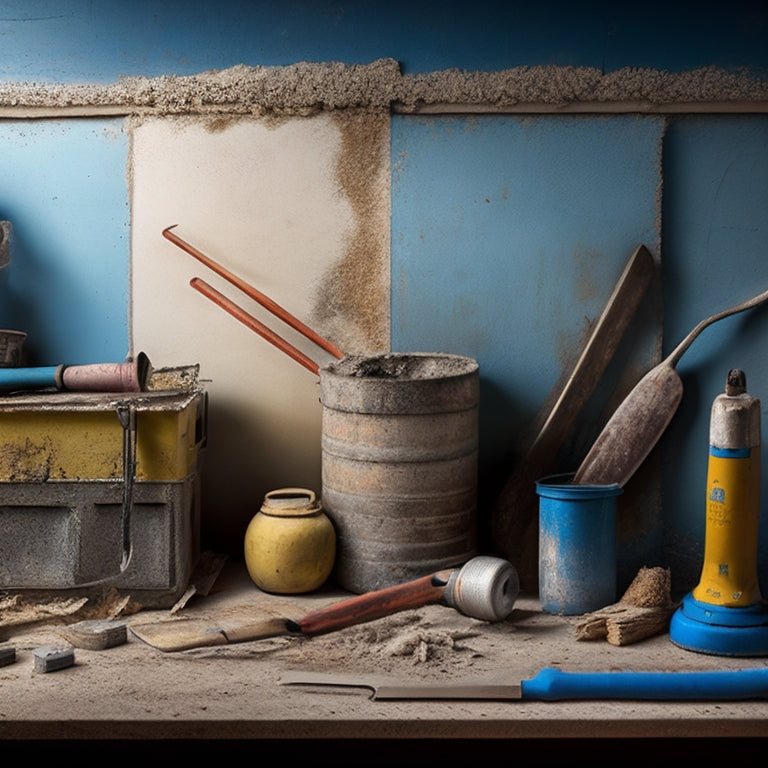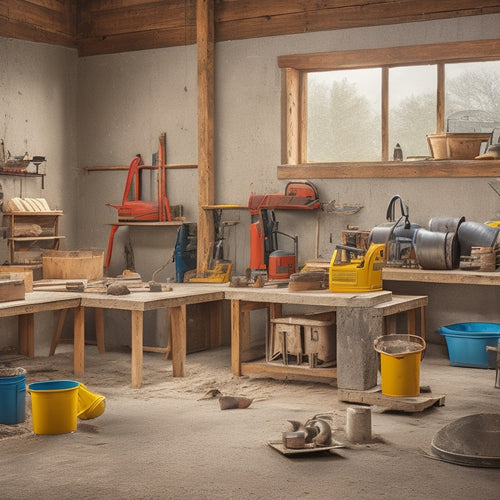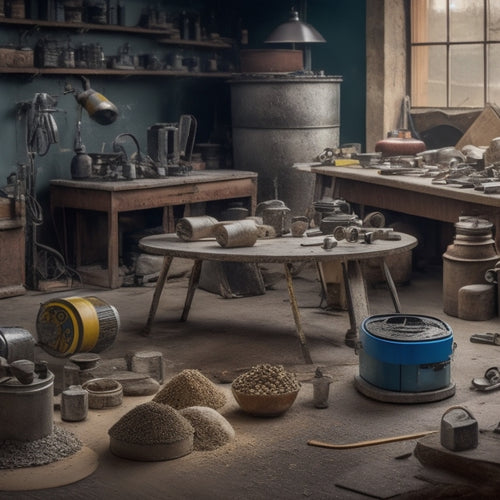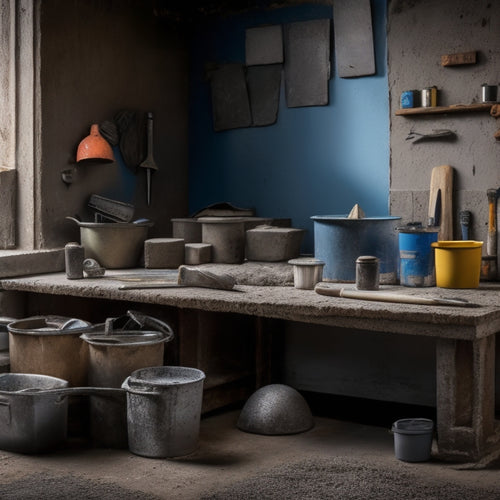
What Tools Remove Old Paint From Concrete Walls
Share
When tackling old paint on concrete walls, you'll need the right tools for the job. Scraping tools like putty knives, floor scrapers, and wire brushes are effective for removing flaking or peeling paint, while chemical strippers dissolve and lift old paint for easier removal. Power washing and sanding blocks can also be used to remove paint, and infrared heat guns can soften old paint for efficient scraping. For tough paint, grinding tools like angle grinders with diamond blades can be employed. With the right tools and techniques, you'll be well on your way to stripping old paint from your concrete walls, and by exploring further, you'll uncover the nuances of each method to achieve excellent results.
Key Takeaways
• Scraping tools like putty knives, floor scrapers, and wire brushes remove old paint from concrete walls, especially in crevices and corners.
• Chemical strippers dissolve and lift old paint for easier removal, with environmentally friendly options available for safe use on walls.
• Power washing with high-pressure settings and wide fan tips effectively removes loose or peeling paint, but maintain a safe distance to prevent damage.
• Sanding tools like sanding blocks with medium-grit blocks and progressing to finer grits remove old paint and smooth the surface.
• Infrared heat guns soften old paint for easy scraping, reducing damage risk and mess, and leaving a clean surface for repainting or refinishing.
Scraping Tools for Cement Blocks
Your go-to scraping tools for cement blocks include putty knives, floor scrapers, and wire brushes, which effectively dislodge old paint from the rough, porous surface. These scraper types are designed to tackle the unique challenges of block materials.
Putty knives, with their flexible blades, are ideal for scraping paint from crevices and corners. Floor scrapers, featuring sturdy handles and rigid blades, provide the necessary leverage to remove thick, stubborn paint layers. Wire brushes, meanwhile, excel at scrubbing away paint residue from the block's textured surface.
When selecting a scraper, consider the condition of your cement blocks. If the paint is flaking or peeling, a putty knife or wire brush might be the better choice. For more stubborn paint, a floor scraper's extra muscle will come in handy.
Remember to always work in small sections, scraping in the direction of the block's texture to avoid damaging the surface. By choosing the right scraper for your cement blocks, you'll be well on your way to removing old paint and achieving a fresh, revitalized look.
Chemical Strippers for Paint Removal
After scraping away loose paint with putty knives, floor scrapers, or wire brushes, you may need to employ a more aggressive removal method, such as chemical strippers, to penetrate and break down the remaining paint layers on your concrete walls.
Chemical strippers are effective in dissolving and lifting old paint, allowing for easier removal. When choosing a chemical stripper, take into account environmentally friendly options that are safe for your walls and the environment.
Here are three key factors to keep in mind when using chemical strippers:
-
Application methods: Chemical strippers can be applied using brushes, rollers, or sprayers, depending on the size of your wall and the amount of paint to be removed.
-
Dwell time: The amount of time the stripper needs to sit on the paint before scraping it off can vary from 15 minutes to several hours, depending on the type of stripper and paint.
-
Neutralization: After removing the paint, it's vital to neutralize the stripper to prevent it from continuing to break down the concrete or affecting new paint applications.
Power Washing Old Paint Away
Using high-pressure power washers can be an effective way to blast away old paint from concrete walls, especially when the paint is already loose or peeling. You'll want to choose the right pressure washer techniques to maximize paint removal efficiency. A wide fan tip and a minimum of 3,000 psi are recommended for best results.
| Pressure Washer Setting | Effectiveness |
|---|---|
| Wide fan tip (25°) | Excellent for covering large areas quickly |
| Narrow fan tip (15°) | Better for concentrating pressure on stubborn paint |
| Low pressure (1,500 psi) | Suitable for delicate surfaces or removing loose paint |
| High pressure (4,000 psi) | Ideal for blasting away thick, stubborn paint |
When using a power washer, keep the nozzle at least 12 inches away from the wall to avoid damaging the concrete. Move the nozzle in a consistent, back-and-forth motion to achieve even paint removal. Be cautious not to use too much pressure, as this can damage the underlying concrete. By following these guidelines, you can effectively remove old paint from your concrete walls and achieve a fresh, clean surface.
Sanding Blocks for Smooth Finish
When you're preparing to sand away old paint from concrete walls, it's crucial to choose the right sanding block and approach.
You'll need to select a block that suits your wall's condition, then pick the appropriate grit level to achieve a smooth finish.
Block Selection Tips
You'll typically reach for a medium-grit sanding block to start removing old paint from concrete walls, as it effectively breaks down the paint's bond with the surface. This is because medium-grit blocks provide an ideal balance between aggressive paint removal and surface preparation. However, it's crucial to choose the right block type for your specific project.
When selecting a sanding block, consider the following factors:
-
Block density: A denser block is better suited for aggressive paint removal, while a less dense block is ideal for fine-tuning the surface.
-
Block size: A larger block covers more surface area, but may be harder to maneuver in tight spaces.
-
Block material: Foam blocks are gentle on surfaces, while rubber blocks provide more aggressive paint removal.
Grit Levels Matter
By the time you've selected the right sanding block for your project, it's essential to pair it with the appropriate grit level to achieve a smooth finish on your concrete walls.
The right grit selection is important in guaranteeing effective paint removal and promoting strong paint adhesion. A coarse grit (around 80-100) is ideal for removing thick, old paint, while a finer grit (120-150) is better suited for smoothing out the surface.
As you progress through the sanding process, you'll need to switch to even finer grits (220-240) to achieve a high-gloss finish. Remember, using the wrong grit can lead to scratches, swirl marks, or even paint that peels off prematurely.
Take your time to choose the right grit sequence for your project, and you'll be rewarded with a surface that's not only smooth but also ready for a fresh coat of paint. By doing so, you'll guarantee a strong bond between the new paint and the concrete wall, giving you the freedom to enjoy your newly refurbished space.
Sanding Patterns Help
To guarantee a smooth finish, adopt a systematic sanding pattern, working in small sections and using overlapping strokes to maintain even pressure and prevent skips. This approach helps you achieve a uniform removal of old paint from your concrete walls.
As you sand, focus on maintaining consistent pressure and direction to avoid creating scratches or swirl marks.
Effective sanding techniques rely on pattern effectiveness. Here are three key considerations to keep in mind:
-
Directional control: Always sand in the direction of the wood grain or concrete texture to prevent scratches.
-
Overlapping strokes: Use overlapping strokes to ascertain complete coverage and prevent missed spots.
-
Sectional sanding: Divide the wall into smaller sections, completing each one before moving on to the next, to maintain even pressure and prevent fatigue.
Wire Brushes for Aggressive Removal
Wire brushes prove effective for aggressive removal of old paint from concrete walls, especially when dealing with thick, stubborn coatings.
You'll find that wire brushes are available in various types, each suited for specific paint removal tasks. Stainless steel wire brushes are ideal for removing latex-based paints, while brass wire brushes work well with oil-based paints. You can also use wire brushes with different gauge sizes, which refer to the thickness of the wire bristles. A smaller gauge size means finer bristles, perfect for detailed work, while a larger gauge size is better for rough, heavy-duty removal.
When using wire brushes, remember to maintain them properly to extend their lifespan. You should regularly clean the brushes with soap and water to prevent paint buildup. Also, store them in a dry place to prevent rust.
Using Infrared Heat Guns
When you're faced with stubborn old paint on concrete walls, using an infrared heat gun can be a game-changer.
You'll find that this tool offers several benefits, which we'll explore shortly.
Infrared Heat Gun Benefits
Using an infrared heat gun allows you to efficiently soften old paint, making it easier to scrape off, and reducing the risk of damaging the underlying concrete wall. This is possible due to the advanced infrared technology that provides unparalleled heat efficiency.
With an infrared heat gun, you can remove old paint quickly and safely, giving you the freedom to restore your concrete walls to their original condition.
Here are three key benefits of using an infrared heat gun:
-
Faster removal: Infrared heat guns can soften old paint in a matter of minutes, allowing you to remove it quickly and efficiently.
-
Reduced risk of damage: The gentle heat from the infrared gun reduces the risk of damaging the underlying concrete wall, giving you peace of mind during the removal process.
-
Easy cleanup: With the old paint removed, you're left with a clean surface that's ready for repainting or refinishing, giving you the freedom to create the look you want.
Heat Application Techniques
To guarantee effective paint removal, you'll need to apply heat from your infrared heat gun in a consistent, sweeping motion, holding the gun 6-8 inches away from the concrete wall. This technique enables efficient heat transfer, allowing the paint to soften and loosen its bond with the concrete. Move the gun in sections, overlapping your passes to ascertain uniform heat distribution. As you work, maintain a steady pace to prevent overheating, which can damage the concrete or create hot spots.
Proper surface preparation is vital for successful paint removal. Before applying heat, make sure the concrete wall is free of dirt, grime, or oil-based substances that could interfere with the heat transfer process. If necessary, clean the surface with a degreaser or wire brush to create an ideal environment for paint removal.
Removing Old Paint Easily
With your infrared heat gun properly set up and the concrete wall surface prepared, you're ready to begin removing old paint easily. This effective cleaning method uses heat to loosen the paint's bond with the concrete, making it simpler to scrape off. As you work, keep the heat gun moving in slow, even passes to avoid overheating the surface.
Here are three key benefits to using infrared heat guns for paint removal:
-
Efficient: Infrared heat guns can remove multiple layers of paint in a single pass, saving you time and effort.
-
Selective: The heat gun's targeted heat application allows you to remove paint without damaging the underlying concrete.
-
Low-mess: By loosening the paint before scraping, you'll generate less dust and debris, making the process cleaner and more manageable.
As you continue to work, be sure to scrape off the loosened paint regularly to maintain a clean surface.
With the right technique and the power of infrared heat, you'll be able to remove old paint easily and efficiently, revealing a fresh, clean surface beneath.
Grinding Tools for Tough Paint
You'll need a robust grinding tool to tackle tough, old paint on concrete walls, as it can withstand the abrasive nature of the paint and the rough surface of the concrete. For this, angle grinders are a popular choice. They're versatile, efficient, and can be fitted with various accessories to suit your needs.
When it comes to removing old paint, diamond blades are an excellent option. These blades are designed to cut through tough materials, including concrete and old paint. They're available in different grits, allowing you to choose the right level of aggression for your project.
With an angle grinder and a diamond blade, you'll be able to grind away the old paint, revealing a smooth, clean surface. Remember to work in small sections, using a consistent motion to avoid scratching the concrete.
As you grind, use a vacuum or a damp cloth to remove the dust and debris, ensuring a safe and efficient removal process.
Safety Precautions for Removal Process
As you switch to removing old paint with your angle grinder and diamond blade, don't forget to prioritize your safety above all else. The removal process can be hazardous, and it's vital to take necessary precautions to avoid injuries and health risks.
To guarantee a safe removal process, remember to:
-
Wear personal protective equipment (PPE), including safety glasses, gloves, and a dust mask to prevent paint particles and debris from causing harm.
-
Implement ventilation measures, such as opening windows or using a ventilation system to remove paint fumes and particles from the air.
-
Clear the area of tripping hazards, including cords, tools, and debris, to prevent accidents and falls.
Frequently Asked Questions
Can I Use a Blowtorch to Remove Old Paint From Concrete Walls?
You're considering using a blowtorch to remove old paint from concrete walls, but be cautious - it's not the safest option.
Blowtorch safety is a major concern, as it can cause burns and start fires.
Instead, explore alternative methods like chemical strippers, sanding, or power washing.
These approaches are more effective and safer for you and your surroundings.
How Do I Protect Adjacent Surfaces During Paint Removal?
You're wise to think about protecting adjacent surfaces during paint removal.
Theory has it that a well-prepped workspace is key to a successful project. In reality, it's essential.
You'll want to apply protective coverings, such as drop cloths or plastic sheets, to any surrounding areas you don't want damaged.
Additionally, use surface masking products like tape and film to create a seal around windows, doors, and trim.
This extra effort upfront will save you time and hassle in the long run.
Can I Reuse Chemical Strippers on Multiple Projects?
When considering reusing chemical strippers on multiple projects, you'll want to weigh the pros and cons.
While reusing can be cost-effective, it may compromise the stripper's potency, leading to reduced effectiveness and increased project timelines.
Assess the chemical stripper's longevity and calculate the true cost of reusing versus buying new.
You'll find that investing in fresh strippers often yields better results, saves time, and ultimately boosts your project's overall freedom from paint removal headaches.
Are Wire Brushes Effective on Epoxy-Based Paint?
You're wondering if wire brushes are up to the task of tackling epoxy-based paint.
Let's get straight to it - the answer is, it's complicated.
Epoxy paint is notoriously stubborn, and wire brushes can be effective, but only to a certain extent.
The thick, hardened layers will put your brush to the test, and you might find yourself struggling to make progress.
But don't worry, there are ways to overcome these challenges, and we'll explore them together.
Do I Need to Prime the Wall After Removing Old Paint?
Now that you've removed the old paint, you're wondering if you need to prime the wall. The answer is yes, you should.
Priming guarantees ideal paint adhesion and surface preparation, which are critical for a durable, long-lasting finish. Without priming, the new paint may not bond properly, leading to peeling or flaking.
Take the extra step to prime the wall, and you'll enjoy a beautiful, hassle-free finish that will make you feel free to enjoy your newly refreshed space.
Conclusion
Finesse your facades by fearlessly fighting faded finishes. From scraping to stripping, washing to wire-brushing, you've wielded the weapons to wipe out worn-out wall wear.
Sanding and grinding tools smoothed out stubborn spots, while infrared heat guns brought blistering breakthroughs. With these potent paint-removal methods, your concrete walls are now primed for a fresh new look.
By embracing this ensemble of effective techniques, you've conquered the complexities of old paint removal, uncovering a canvas ripe for renovation.
Related Posts
-

What Tools to Rent for a Concrete Home Reno
When tackling a concrete home renovation, you'll need to rent a variety of specialized tools to get the job done. For...
-

Top DIY Concrete Grinding and Polishing Tools
When selecting DIY concrete grinding and polishing tools, you'll want to take into account a range of factors to guar...
-

Top Tools for Beginners in Concrete Masonry Coating
You're about to begin a concrete masonry coating project, and having the right tools is essential. Start with essenti...


